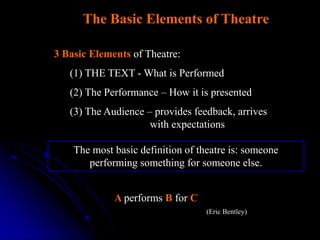
Qualities of theatre
- 1. The Basic Elements of Theatre 3 Basic Elements of Theatre: (1) THE TEXT - What is Performed (2) The Performance – How it is presented (3) The Audience – provides feedback, arrives with expectations The most basic definition of theatre is: someone performing something for someone else. A performs B for C (Eric Bentley)
- 2. Interaction Between the 3 Basic Elements of Theatre Text Audience Performance
- 3. TEXT: What is Performed • Many types of activities may be considered Theatre • What is the essence of theatrical performance? Possibilities: • The staged performance of a text • Storytelling • Entertainment such as juggling or improvisation • Since Theatre has a broad range of possibilities, the essence of What is Performed is difficult to define • Therefore Theatre, as a performing art, is difficult to define
- 4. The Performance The Performance translates the potential of a script, scenario, or plan into actuality. Key Components of the Performance include: • Performance Space where the performance takes place and what the relationship is between the performers and the audience • Artistic Collaboration how the playwright, director, designers and others work together to create the Performance • Theatrical Elements Scenery, Costumes, Music, Lighting and other effects that contribute to the Performance
- 5. Performance Studies perspective What other forms of performance exist?
- 6. The Audience “The only thing that all forms of theatre have in common is the need for an audience.” Peter Brook The Audience: • Completes the cycle of Creation/Communication • Provides Immediate Feedback to the Performers 3-Way Interaction: Performers Audience Audience Performers Audience Audience (And also Performer to Performer in and out of character)
- 7. Elements of Theatre Spectatorship “Willing Suspension of Disbelief” • Term from Samuel Taylor Coleridge • We know that the events of the play are not real. • However, we agree, during the experience of the performance, not to disbelieve the events of the play. Example: • When a character kills another character onstage, we do not rush to the stage to help the victim, yet we may still weep or feel an emotional response to the action.
- 8. 3 Thing Theatre can do: Educate Entertain Inspire
- 9. Special Qualities of Theatre Lifelikeness Theatre recreates everyday experiences. Ephemerality Theatre is live performance, and becomes a part of the past immediately after it occurs. Objectivity Theatre “presents both outer and inner experience through speech and action.” Complexity Theatre combines varied elements such as movement, lighting and sound while also drawing from all of the other Arts. Immediacy Theatre is psychologically immediate, because it transpires in the simultaneous presence of live actors and spectators in the same room.
- 10. Popular Culture vs. Elitist Culture Popular Culture Reflects tastes of the general public Theatre that appeals to Popular Culture = entertainment, storytelling, familiar character types and situations, MTV, Rap, Hip Hop, Real World programs and Reality TV. Elitist Culture Reflects tastes of a smaller group with particular standards Theatre that appeals to Elitist Culture = seeks new types of artistic expression, challenges views and assumptions, raises questions. (BUT how might this also be part of popular culture entertainment?)
- 11. Question: what does class have to do with the attendance and appreciation of live Theatre? Does economics play a role in how people appreciate theatre in society today?
- 12. Useful Arts = Arts that can be taught and mastered through specific techniques Fine Arts = Products of genius that cannot be reduced to rules or principles Examples: • Literature (including Drama) • Painting • Music • Dance
- 14. Fountain In 1917, one "Richard Mutt" entered a urinal as a sculpture in an exhibit organized by the New York Society of Independent Artists (of which Duchamp was a founding member and whose stated policy was to accept "any work by any artist who paid the six dollar fee"*). The piece was rejected without discussion. Duchamp defended the piece in the magazine The Blind Man, (which he edited), with these words: "Whether Mr. Mutt with his own hands made the fountain or not has no importance. He chose. He took an ordinary article of life, placed it so that its useful significance disappeared under a new title and point of view ...[creating] a new thought for that object." When the "morality" of such an object was questioned he responded, "It is a fixture that you see every day in plumbers' show windows... The only works of art America has given [us] are her plumbing and her bridges."
- 15. What do YOU think? 1. What is ART? 2. Is theatre only for the affluent? 3. Why does theatre not thrive as a form of entertainment in society like the cinema?
- 16. Purposes of Art • Art as a means to understand one’s world • Like other disciplines, such as history, Art seeks to discover and record patterns in human experience. • While historians, scientists and other scholars appeal to the mind/intellect, Artists appeal to the senses. • Both are valid forms of acquiring knowledge and learning more about the world in which we live
- 17. Purposes of Art 1. Art is mimetic a. Imitation of something natural or imagined b. It is not real, it cannot be c. Hence since it is contrived it can be controversial. d. Art condenses human experience by stripping away the irrelevant details. Does it reflect reality or create it? Does it describe behavior, or prescribe behavior? Give an example in either Style, fashion, attitude, language.
- 18. Genres 1. Tragedy 2. Neoclassic Tragedy 3. Shakespeare & Jacobean drama 4. Romantic Drama 5. Modern Tragedy 6. Comedy 7. Tragic Comedy 8. Melodrama 9. Postmodernism